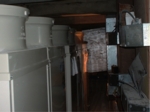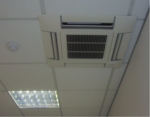Exposing the flaws in air-conditioning systems

This inappropriate positioning of air-cooled condensing units will starve the system of ambient air onto the condensing units, and the restricted discharge will cause recycling. In this position the units would never operate efficiently in heating/cooling modes, and unless urgently addressed the life of the compressors will be reduced by repeated stopping and starting.
Mike Nankivell explains how the requirements of the Energy in Buildings Performance Directive for most commercial air-conditioning system installations to be inspected and the F-Gas Regulation’s leak-checking procedures should address some of the more basic design flaws, user error and maintenance failings that result in poor operating efficiency.Contrary to popular belief, the rare event that our fickle English weather delivers a mini heat wave does not immediately produce a sudden increase in sales of air-conditioning equipment. While sales orders are boosted by better weather, in my experience, in a heat wave, mini or otherwise, the first flurry of enquiries come from overheating building occupants anxious that their existing air-conditioning equipment is under-performing or worse, not working at all. It is worryingly common to learn that the equipment in question is not the subject of regular, professional maintenance. Perhaps even more alarming is that problems are being experienced despite maintenance contracts being in place. As equipment suppliers, receiving calls from end users reporting that their air-conditioning system has failed or is not coping with more extreme conditions, there is not usually much we can do beyond advising that a reputable specialist is called in to check the problem out. Occasionally our own after-sales technical support engineers have an opportunity to carry out inspections and make some interesting discoveries — some of which are described or illustrated. It is a sad fact that many air-conditioning systems do not perform as actually designed. Regrettably, it is also a fact that building services are often not properly commissioned. This will contribute to the estimate that on average, commercial buildings in the UK are consuming 35% more energy than they should. The result is far more serious than a matter of the building being over- or under-heated, cooled or ventilated. Such conditions are not only highly undesirable for the occupants, leading to complaints, absenteeism and reduced productivity, but also to significant increases in operating costs, which in turn increases the building’s environmental impact in terms of carbon emissions. Another important factor is that many design, installation, commissioning, maintenance and user/operator errors are frequently the cause of premature failure of the equipment itself. The changes that can occur between system design and system operation vary for a multitude of reasons. These can range from installation and commissioning issues, changes in building layout and use, poor maintenance or lack of it, how the system is controlled and operator error. One should not overlook the possibility that the original system design might also have been ill considered or that the equipment is inherently inefficient. The introduction of mandatory inspections of all air conditioning systems with a rated cooling output greater than 12 kW by the UK Government as part of the implementation of the Energy Performance of Buildings Directive will provide building owners and operators with essential information and guidance on the energy performance of their air conditioning systems. Similarly the F-Gas Regulation’s regime for checking refrigerant leaks will become another helpful process towards realising the optimum efficiency of air conditioning systems. By identifying the potential for improvements in the energy efficiency of the systems, EPBD inspections, which can only be conducted by properly accredited assessors, will encourage actions that, if effected could dramatically reduce electricity consumption and operating costs.

This cassette has been installed so close to a wall that the discharge pattern of the airflow will influence the room temperature sensor mounted on the wall (highlighted) and result in control issues.
The impact on air-conditioning efficiency in the event of refrigerant leaks is quite dramatic; for example, a 15% loss of refrigerant can equate to a 50% drop in operating efficiency — therefore regularised F-Gas leak checks and the legal requirement for leaks and their repairs to be recorded in a maintenance log will serve to reduce such efficiency losses. The overall objective of all these measures is to reduce the carbon emissions essential for the wellbeing of our global environment. What are the inspections likely to reveal? In many cases, particularly with smaller or relatively simple systems, it may just be a matter of addressing the kind of elementary problems all too often discovered when responding to complaints of poor performance. A few classic examples are illustrated. None of the illustrated examples are particularly uncommon and in most cases can be resolved relatively painlessly. However, as each and every one can lead to increased operating costs and in consequence the carbon footprint of a building, one might begin to understand what can contribute to unnecessary energy consumption statistics. Although the mandatory EPBD air-conditioning inspections and F-Gas Regulations introduce extra burdens on building operators, there can be little doubt that the potential to improve the efficiency of our building stock will bring about enhanced occupancy comfort, reduce running costs and help to meet the Government’s carbon-reduction targets.
Mike Nankivell is marketing and business-development manager for Daikin distributor Space Airconditioning.

One of the most common problems compromising the efficient operation of fan coil units is post-occupation fixed and casual obstructions — potentially uncomfortable for the occupants. The effect is also to reduce air flow due to resistance, with a consequent loss in performance and/or an increase in fan power to overcome the added resistance.
Related links:
Related articles:










